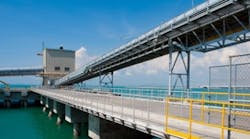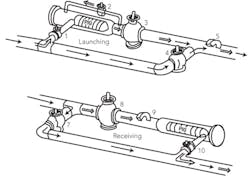"Ask the Experts" is moderated by Béla Lipták, automation and safety consultant, who is also the editor of the Instrument and Automation Engineers' Handbook (IAEH). If you would like to become a contributing author of the 5th edition, or if you have an automation-related question for this column, write to [email protected]
I think the safety of the pipelining industry could be much improved if this data, which could require the shutdown of pumping or compressor stations, could be acted upon immediately. How would you approach solving this problem?
Harry Crowney
[email protected]
A: At today's state of the art, this instant information is not available, not only because signals would be impeded by the steel pipe walls and their water or earth covering requiring unavailable battery power, but also because today's PIGs are not reliable enough to initiate automatic shutdown that can result in excessive pressure surges. PIGs today are good only to detect gradual phenomena, such the decrease of pipe thickness. Information obtained from pigging is used only for operator warning. Events requiring immediate action, such as pipe damage due to earthquakes, ship anchors or terrorist action, have to use other techniques. What is feasible, though, is to transmit the data collected as soon as the PIG is retrieved from the pipe (Figure 1), and use computer software to speed the evaluation of and response to that data.
Figure 1. The Launching operation is initiated by opening valves 1, 2, 3 and closing valve 4. Launching is terminated automatically by the PIG passage detector (5), which initiates the reversal of the previous valve positions. During a Receiving operation, valve 7 is closed, 8 and 10 are opened, and when the ultrasonic switch (9) signals the PIG's arrival, the valve positions are reversed and normal operation resumes.
Béla lipták
[email protected]
A: I am not an expert in the use of PIGs, but I would say it's situational. Use of real- time telemetry depends on many factors; e.g., depth of the pipe and substrate above the pipe; the type of media (behind or in front of the PIG) in the pipe; length of pipe; number of bends, etc. Acoustic or RF telemetry, fiber-optic or copper spools at the launcher and on the PIG are just a few examples of how data can be transported in real time. Bottom line: We need more data to provide a solution. Budget, timeline and performance requirements (bandwidth, data rates, etc.) are an obvious consideration as well.
Keith Sommer
[email protected]
A: I don't know that I would agree with Mr. Crowney's statement at all. Corrosion and ultimate failure of a pipeline is a rather slow process that usually takes months (if not years) to occur. In most cases, a degrading pipe will be inspected many times before it ultimately fails, providing many opportunities to identify a developing problem and correct it prior to disaster. (Of course. this assumes that the pipeline is inspected at all.)
It seems highly unlikely that a PIG sensor would detect an impending failure that had never been sensed in any of the previous inspections, and so the ability of the pig to shut down the pipeline immediately rather than waiting for the inspection team to interpret the data and notice the problem would markedly improve safety.
On the flip side, Mr. Crowney does not mention the innumerable false shutdowns that would invariably occur every time a PIG sensor malfunctioned or sensed a pipeline abnormality. It seems that the resulting pressure surges of stopping and restarting the pipeline for needless interruptions would cause far more safety issues than the PIG shutdown system would avert.
P. Hunter Vegas
[email protected]
A: Intelligent PIGs nowadays collect all relevant pipeline data. "Pigging" is a process which is deterministic and used on an "as when required" basis. Pipeline leakage or cracks are random phenomenon. Moreover, PIGs often acquire incorrect or garbage information.
Any ESD executive action shall be based on a proven system (leak detection or pipeline integrity system). Therefore, for shutting down a block valve station or compression station, in my opinion, an intelligent PIG should not be used. However, operator alerts can be generated for further action/investigation.
Debasis Guha
[email protected]
A: Although I am not an expert in pigging systems, pipeline integrity and continuous leak detection is best performed by specialized software programs. Intelligent PIGs are used to collect and store data in their memory because transmitting data while they travel through the pipeline requires a lot of battery power. PIG-tracking transmitters and receivers are available from a number of vendors. However these are restricted to information about the PIG's location rather than data transmission. If Harry is interested, he can contact PPSA and get more information on the latest developments from PIG manufactures and end users.
Ray Binney
[email protected]
A: Pigging is usually not the only non-destructive, periodic test carried out on the pipe. Usually, there will be an inspection frequency set to examine some or all of the pipe from the outside, especially for major pipelines.
The combination of periodic pigging and external examination should be sufficient to trend the integrity of the pipe in normal circumstances, provided that the frequency of these inspections is set within a reasonable time frame. This time frame will be affected by the type of material flowing in the pipe (corrosive, clean/dirty service, etc.).
All the data from the combination of these inspections is generally trended to provide adequate warning of an impending failure of the pipe. There are also national and international standards that state the minimum thickness and other required parameters to determine the condition of the pipe, and trigger a repair or replacement.
There may be abnormal circumstances that warrant additional inspections—pipe hit by anchor, dragged by ship, potential damage from earthquake, etc. These normally would be evaluated by visual inspection as a first step. If the PIG is traveling through a steel pipe, then the transmission of a data signal will be impeded by the pipe acting as a shield and by the depth of the pipe underground or under water.
So while it may be advantageous to receive real-time data, it may not be practical. If data is being lost because of electronic failures, then perhaps the integrity of the electronics inside the PIG could be improved with better diagnostics and/or redundancy, but it is likely this has already been implemented in modern PIGs. Design and certification of the data collection systems to IEC61508 may help to improve the integrity of the electronics; however, the cost of this would need to be weighed against the benefit if existing PIGs already have high reliability.
You can review what happened at Veranus Island This pipeline failure is interesting. A section of the pipeline between offshore and onshore was neglected because the company responsible for the offshore section of pipe believed the company responsible for the onshore section of pipe was responsible for that particular section of the pipeline, and vice-versa. Consequently, that section of pipe was neglected and finally failed.
Dr. Raymond Wright
[email protected]
A: Smart PIG systems are used to collect pipeline data that are analyzed offline to identify defects and potential dangers to the integrity of the pipeline. No PIG system initiates any safety action, as the data collected is not capable of taking the decision.
Pipeline defects arise over time and require comparison between periodic records for correlation. Hence, I do not see a direct link between smart PIGs and safety systems. There are other pipeline monitoring systems for leaks that use patented software to identify any leaks/failures early, and initiate warnings or shutdowns.
L.Rajagopalan
[email protected]






